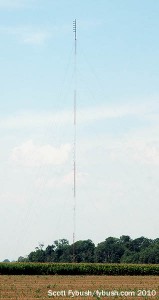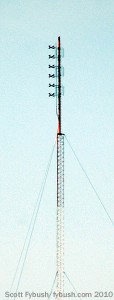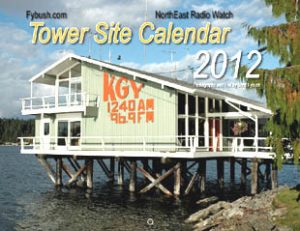NorthEast Radio Watch 12/8/2025: Cichon’s Back in Buffalo
In this week’s issue… Veteran newsman returns - Remembering NY's Leitner, RI's Jones - CT AM saved - Maine AM moves - "Indie" adds suburban signals
In last week’s Site of the Week installment, I talked about how often my travels take me through the Cleveland area, and how infrequently I manage to take some time to stop and sniff the RF, as it were.
If Cleveland gets ignored too often by this column, then Toledo really gets the shaft. Just two hours or so from our frequent destination of Fort Wayne, Toledo is usually the “we’re almost at the end of the trip, so let’s come back and see Toledo stuff another time” city if we’re westbound, or the “no time for Toledo towers right now, what with eight more hours of driving ahead of us” city if we’re heading back east.
But in the summer of 2010, after 19 years of routinely bypassing Toledo, we ran out of excuses. We’d gotten an early start out of Rochester, the weather was spectacular, there was no hurry to get to Fort Wayne that evening…and so we spent some time checking out some new and old sites all lined up along US 20, most of them with a mile – one single mile – of the Ohio Turnpike (I-80/90) where we’d been schlepping back and forth probably close to a hundred times over the years.
We’d even exited the Turnpike many, many times at exit 71, the easternmost Toledo exit. Go north there and you’re on I-280, the highway that loops up to the east side of Toledo by way of the historic three-tower array (and Art Deco building) of Toledo’s oldest station, WSPD (1370). Toledo’s TV and FM tower farm is up that way too, on the flat land south of the Lake Erie shore and east of the city.
But we turned south instead, not just for the cheap gas to be found along State Route 420 (usually the cheapest to be found anywhere on our Fort Wayne-to-Rochester route) but this time to take 420 the short mile to its end at US 20/23, the “Fremont Pike.” It’s about four miles west on 20/23 from the 420 interchange to the corner where Lime City Road and a set of railroad tracks cross at a diagonal – and it’s there that we find WJYM (730), licensed to Bowling Green a dozen miles to the south but very much serving Toledo, to the north.
The 730 signal started out in the 1960s in Bowling Green itself, first as WWBG and then WTLG (“We’re Toledo’s Little Giant,”) but by the end of the decade it had relocated here and changed calls to WHRW, reflecting the initials of owner Howard Ward. That era didn’t last long, either: by the end of the 1970s, 730 was WJYM – as in “Jimmy Swaggart,” the Southern preacher who eventually moved all of the station’s operations down to his base at WJFM in Baton Rouge, Louisiana. Today, the only thing local about WJYM is these four towers, cranking out 1000 watts by day and dropping to 59 watts overnight.
If Jimmy Swaggart was a pioneer of remote operation of a network of religious stations, the concept was honed to perfection by California-based EMF Broadcasting – and they’re also represented here along the US 20 corridor, with an AM station no less. Wat’s “K-Love” doing on WNWT (1520)? Time, once more, for some history…


The 1520 signal in Toledo went on the air in 1966 as WTTO, kicking off a long run of format and call changes (WTUU, WANR, WGOR, WVOI, WDMN) and becoming the answer to a fun radio trivia question: “What radio station has transmitters in two states?”
The original 1520 operation was a dual-site facility, with studios and a six-tower daytime array just north of the state line in Bedford Township, Michigan, aiming southeast into Ohio and protecting another 1520 daytimer just 50 or so miles to the west in Bryan, Ohio. But at night, 1520 had to protect the big boomers in Buffalo (WKBW) and Oklahoma City (KOMA) on the channel – and that required a six-tower inline (!) site southeast of Toledo, right at the junction of I-75 and I-80/90, aiming northwest.
Over the years, that night site decayed pretty badly, and in the last years of the two-site operation it was really a one-site operation, with the night signal on a low-powered STA from the Michigan day site. By then, the station was owned by the local Cornerstone Church and had flipped from black gospel (“Dominion 1520”) to talk as WNWT. In 2009 Cornerstone relocated WNWT to a new fulltime six-tower array about a mile south of WJYM on Five Point Road, where it’s now licensed to suburban Rossford and running 500 watts day, 400 watts at night. And it was around that time that Cornerstone, which had been leasing its FM station, WXQQ (96.9 Wauseon, later WNKL) to EMF, sold both signals outright to the California broadcaster. EMF is usually quick to sell off AM stations that it acquires, but for some reason it’s held on to WNWT, which continues to carry “K-Love.”
(Want to see the old 1520 sites from the air? Our friend Fred Vobbe – we’ll hear more about him in next week’s installment – took a scenic flight over a whole bunch of Lima, Toledo and Detroit sites back in 2001, all chronicled here.)
There are FMs out here along US 20, too: Clear Channel’s top-40 “Kiss” WVKS (92.5) broadcasts its class B signal from a 500-foot tower on Neiderhouse Road, a mile or so west of WJYM where the farmland starts to butt up against the suburbia of Perrysburg.
Go east on US 20/23, away from Perrysburg and out past the 420 interchange, and right where 23 splits off from 20 is another FM stick carrying two signals. What’s now WIMX (95.7 Gibsonburg) signed on out here in 1988 as WRED, a callsign that later migrated to Toledo’s AM 1560; back then, its studios were in that little building in the foreground. WJZE (97.3 Oak Harbor) signed on out here in 1993, and today both of these stations run urban-oriented formats, a bit incongruous for class A signals 15 miles or so out of town in the middle of farmland.
But if you really want some heavy-duty “tower in the middle of farmland way out of town,” the place to be is north of Elmore, Ohio, and you can get there (as we did) by continuing out 20 east for a few more miles into Woodville, then turning north on Ohio 105 across the Turnpike. It’s way out here that we find the 620-foot tower of Cumulus’ WXKR (94.5 Port Clinton), a surprisingly old class B station that started out in 1961 as WRWR, local to Port Clinton. In the early 1980s, WRWR moved toward the Toledo market as WOSE (serving “Ottawa, Sandusky and Erie” counties) and eventually built this stick here to serve Toledo, which it does quite well.
WXKR is one of the few Toledo signals running HD, primarily so Cumulus can use its HD2 subchannel to feed a Toledo FM translator, W264AK (100.7). Remember our mention of AM 1560, the station long known as WTOD? Cumulus traded the AM license to Calvary Chapel of Twin Falls a couple of years ago in exchange for that FM translator, which now does modern rock as “The Zone.”
(Did you think we’d break our streak of TSoTW installments mentioning our pal Mike over at NECRAT.us? Not just yet – while he wasn’t along with us on this particular journey, he was headed westward just a few days after we were, and the next few weeks will chronicle the loop we took through Lima, Dayton, Cincinnati and up into southwestern Indiana. Stay tuned!)
 Check out our spring clearance specials on the world-famous Tower Site Calendar 2012, available from the all new Fybush.com store!
Check out our spring clearance specials on the world-famous Tower Site Calendar 2012, available from the all new Fybush.com store!
Want access to more than a dozen years’ worth of Tower Site of the Week? All our archives, fully searchable, are available to Fybush.com subscribers – and you get full access to NorthEast Radio Watch, too! Subscriptions start at just $15. Sign up here!
And don’t miss a bunch of Toledo IDs next Wednesday, over at our sister site TopHour.com!
Next week: TBA
In this week’s issue… Veteran newsman returns - Remembering NY's Leitner, RI's Jones - CT AM saved - Maine AM moves - "Indie" adds suburban signals
In this week’s issue… Scripps stations face takeover - Sinclair moves more affiliations - CT stations sold - Maine AM surrendered - Remembering WVBR's Shapiro, WABC's Morgan
In this week’s issue… CT TV legend succumbs to cancer - Remembering PA's Adams - FCC still stalled by shutdown - Pittsburgh morning host exits
In this week’s issue… FCC faces reopening challenges - Veteran Boston anchor retires - Morning shift in Toronto - NYC FMs expand reach